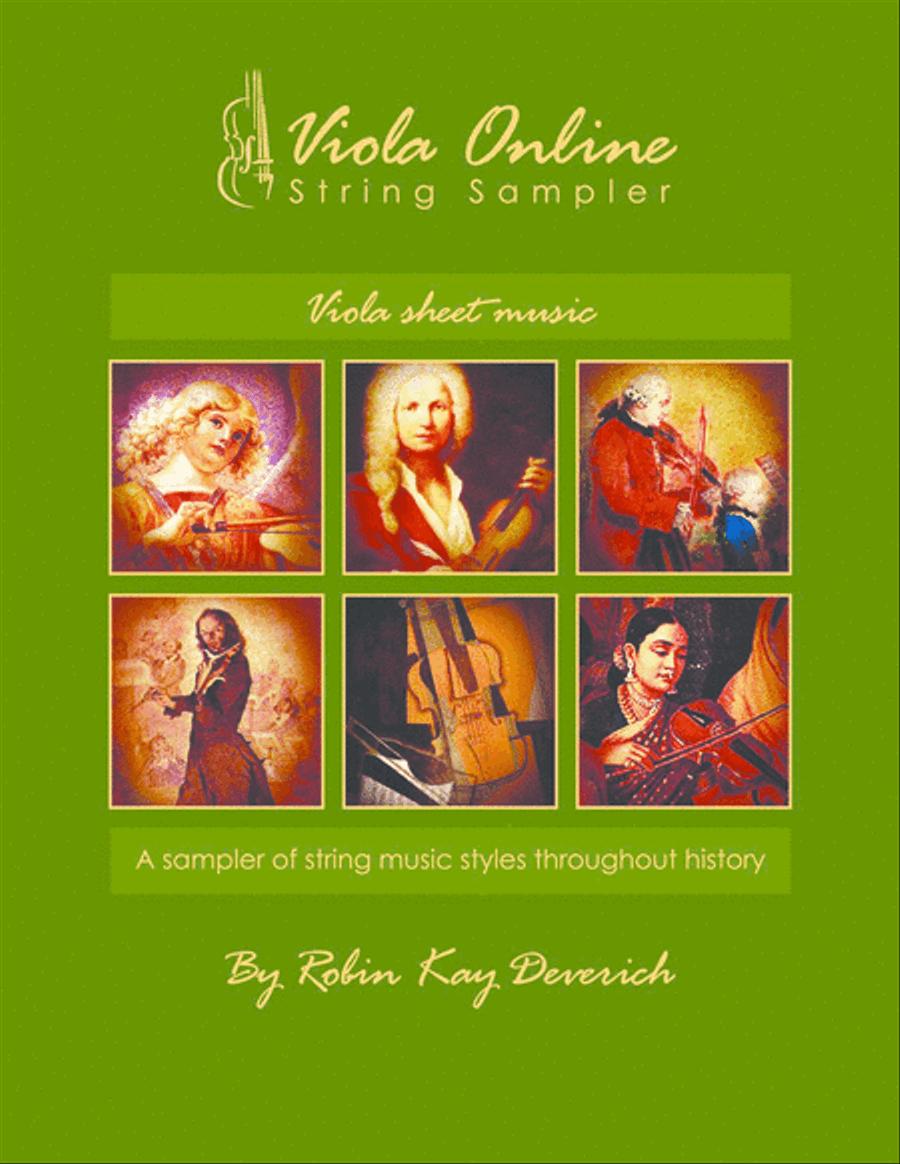Viola Solo - Digital Download SKU: A0.902206 Arranged by Robin Kay Deverich. Contemporary. Individual part. 82 pages. Global Music School String Publications #5355047. Published by Global Music School String Publications (A0.902206). Viola Online String Sampler Viola Sheet Music is a fun and easy way to actively learn, study and play beautiful viola music from a wide variety of styles and eras. 54 pieces are featured, representing music history periods, cultures and styles such as Medieval, Renaissance, Baroque, Classical, Romantic, 20th Century, Fiddle, Klezmer, Gypsy, Chinese, Greek, Carnatic, Arabic, Mariachi, Ragtime and Blues. These arrangements have been simplified for advanced beginners to intermediate players, and include a representative sampling of most major forms of string music such as concertos, symphonies, sonatas, quartets and trios. As an added bonus, sound files of each piece and a study guide are currently available on the website ViolaOnline.com* as a self-guided class specifically designed to accompany this music: https://www.violaonline.com/stringclass.html The study guide explains the history and musical form of the selected pieces, and includes viola technique tips for each piece of music. Let the music begin! *No guarantees are made that these sound files and website will be available indefinitely.Pieces include: Columba aspexit by Hildegard of Bingen; Sixth Royal Estampie from Chansonnier du Roy; Helas Madame; Kempâs Jigg; Fantasia by Lupo; Minuet from The Fiddle New Modelâd by Crome; Rondeau by Purcell; Hornpipe from Water Music by Handel; La Folia medley by Marais, Corelli, and Vivaldi; Double Violin Concerto in A Minor, Op. 3, No. 8, 1st movement by Vivaldi; Prelude from Cello Suite I in G Major by Bach; Allegro from Brandenburg Concerto No. 5 by Bach; Kyrie from Messa a 4 con violini by Cazzati; Medley: He Shall Feed His Flock Like a Shepherd and Hallelujah Chorus from Messiah by Handel; Arioso from Cantata No.156 by Bach; Ave Verum Corpus, K. 618 by Mozart; Adagio from Violin Concerto No. 3 in G by Mozart; Andante from String Quartet No. 13 in Am by Schubert; Andante from Emperor Quartet in C major by Haydn; Surprise Symphony No. 94, 2nd movement by Haydn; Pastoral Symphony No. 6, 1st and 5th movements by Beethoven; Hungarian Dance No. 5 by Brahms; The Moldau from Ma Vlast by Smetana; Halling from 25 Norwegian Folksongs and Dances by Grieg; Emperor Waltz by Strauss; Vieille Chanson by Viardot; Andante from Violin Concerto in E Minor by Mendelssohn; Allegro and Adagio from Cello Concerto in B minor by Dvorak; Notturno from String Quartet No. 2 in D major by Borodin; Elegy Op. 44 for Viola and Piano by Glazunov; Barcarolla from Sonata in Bb for Viola and Piano by Vieuxtemps; Ave Maria from a theme by J.S. Bach by Gounod/Bach; Sicilienne Op. 78 for cello and piano by Fauré; Meditation from Thaïs by Massenet; Habanera from Carmen by Bizet; Reed Flutes from The Nutcracker Suite by Tchaikovsky; Overture from Pulcinella Ballet by Stravinsky; Moderato from Sonata No. 1 in G Major by Gallo; Assez vif from String Quartet in F Major by Ravel; Sehr langsam from 4 Pieces, Op. 7 by Webern; Simple Gifts melody by Brackett; Braul from Romanian Folk Dances by Bartok; The Basso-Gypsy Traditional; Odessa Bulgarish-Klezmer Traditional; Varys Hasapikos-Greek Traditional; El Jarabe Tapatio-Mexican Traditional; Jasmine Flower-Chinese Traditional; Sara Sara-TyÄgarÄja (Carnatic); Longa Nahawand by Bey (Arabic/Ottoman); Irish Washerwoman-Irish Traditional; Fiddle Medley: Bile Them Cabbage Down, Devilâs Dream and Shuffle-Fiddle Traditional; The Ragtime Violin by Berlin; The Castle Walk by Europe & Dabney; St. Louis Blues by Handy.
